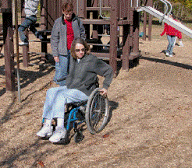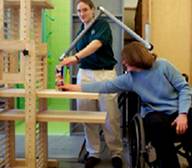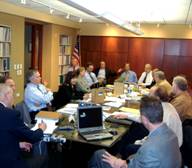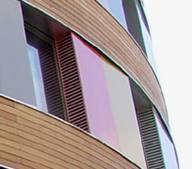Current and Future Research
The Board sponsors and coordinates research to develop guidance materials, to advance work on guidelines under review or development, and to promote accessible design. Each year, the Board initiates a variety of projects, often in cooperation with other entities. Most projects focus on the study of accessibility in relation to architecture and design, human factors, communication, and transportation. Where possible, the Board seeks to undertake research in partnership with other organizations or to build upon existing projects in order to maximize available opportunities with limited funds. For further information, contact Lois Thibault, the Board’s research coordinator, at research@access-board.gov.
Current Projects
Accessible Play and Trail Surfaces (Engineered Wood Fiber)
Surfacing play areas poses challenges to accessibility since materials must be used that are suitable for cushioning falls yet are firm and stable enough for wheelchair maneuvering. Choosing materials that are sufficiently accessible is also an important consideration when developing outdoor trails. This project is examining ways to improve the usability and maintenance of engineered wood fiber, a popular and low cost outdoor surfacing material. The focus is on identifying and testing treatments that are most effective in meeting the dual demands of surface pliability and firmness according to applicable industry standards, specifically American Society for Testing and Materials standards for fall attenuation (ASTM F-1292) and wheelchair accessibility (ASTM F-1951). The study is being conducted by the U.S. Forest Service's Forest Products Laboratory in Madison, Wisconsin. Early phases of the project involved full-scale field assessments to idenitfy the most effective surface stabilizers. Subsequent field tests evaluated the durability of the leading candidates at play areas and trails after exposure to a wide range of climatic conditions. The final phase of the project, currently underway, involves additional field testing at several play area locations in different locations across the country, including Wisconsin, New York, Maryland, and California.
Reports and articles from earlier project phases:
Human Factors and Wheeled Mobility
 The design and functional characteristics of mobility aids have become increasingly diverse over the past few decades. This growing diversity among both mobility aids and people who use them brings into question existing data upon which current accessibility criteria, particularly design specifications for facilities and vehicles, can be assessed. Reliable data on powered devices and their users is particularly lacking. To fill this knowledge gap, the Board is co-sponsoring a multi-year project by the Rehabilitation Engineering Research Center (RERC) on Universal Design to help develop a database on human measures that takes into account the various types of mobility aids now in use.
The design and functional characteristics of mobility aids have become increasingly diverse over the past few decades. This growing diversity among both mobility aids and people who use them brings into question existing data upon which current accessibility criteria, particularly design specifications for facilities and vehicles, can be assessed. Reliable data on powered devices and their users is particularly lacking. To fill this knowledge gap, the Board is co-sponsoring a multi-year project by the Rehabilitation Engineering Research Center (RERC) on Universal Design to help develop a database on human measures that takes into account the various types of mobility aids now in use.
The Center has developed and tested protocols for collecting static and dynamic measurements of people who use various types of wheelchairs and scooters, including space requirements, maneuvering parameters, reach ranges, and other key measures and dimensions. Under this project, a database on mobility aids and user sizes and functional task performance will be established based on measures from 500 subjects. It is anticipated that future anthropometry from other researchers will employ the study's methodology and supplement the database over time so that changes can be captured continuously. In laying the ground work for the project, the Center organized two international workshops on human measures and space requirements for wheeled mobility aids.
Further information on the project, including workshop reports, is available on the Center’s website www.ap.buffalo.edu/idea/Anthro/index.asp.
Wayfinding at Intersections
Design Improvements
This project is exploring design solutions for improving wayfinding for people with vision impairments at intersections. Conducted by the Institute for Transportation Engineers (ITE), this project featured a workshop that brought together highway engineers, orientation and mobility specialists, and people with disabilities to explore potential enhancements to the design of roadways that will facilitate wayfinding. The project will support development and review of standard intersection plans based on recommendations from the workshop. A follow-up workshop focused on wayfinding at shared streets is scheduled for this fall.
Articles on this project published in the ITE Journal (April 2005):
Subject Testing
In addition to the project on improved intersection designs, the Board is also supplementing research by Western Michigan University on wayfinding cues at intersections that involves human subject testing in a controlled environment. This project adds funding to an existing research project to assess the relative usefulness of several tactile and geometric design cues to non-visual wayfinding. These include returned curbs, in-line and directional curb ramps, tactile surfaces, and other cues to wayfinding at street crossings. The Board’s supplemental funding is being used to increase the test sample.
 Materials and Methods
Materials and Methods
The Board’s guidelines for accessible buildings and facilities, including those issued under the Americans with Disabilities Act (ADA), recognize conventional industry tolerances for field conditions. The Board receives many inquiries from design, construction, and code professionals on what tolerances are considered acceptable for various materials and assemblies. This project, which is being conducted by Architectural Research Consulting, Inc., will develop a bulletin on tolerances identified by industry. As part of this project, a workshop was held that brought together representatives of design and construction industry organizations to validate the Board's approach.
Communications in Transportation Facilities and Vehicles
The Board’s accessibility guidelines for transportation facilities and vehicles require that information conveyed to the public be accessible to people with hearing or vision impairments. Under this project, information will be collected and developed to provide guidance on effective strategies and best practices for achieving communication access aboard vehicles and in various types of transportation facilities, including airports, rail and bus stations, at transit stops and on transit vehicles. This material will be made available for use by transportation providers and manufacturers, facility designers, transit system operators, and others.
Indoor Environmental Quality (Phase 2)
 A growing number of people suffer a range of debilitating physical reactions from exposures to everyday materials and chemicals found in building products, floor coverings, cleaning products, and fragrances, among others. There are those who have developed an acute sensitivity to various types of chemicals, a condition known as Multiple Chemical Sensitivity (MCS). In response to these concerns, the Board sponsored a study on ways to improve indoor environmental quality for people with MCS as well as for the population generally. Conducted for the Board by the National Institute of Building Sciences (NIBS), this project brought together various stakeholders to explore issues and to develop an action plan. The project report, issued in 2005, includes recommendations on improving indoor environmental quality. This follow-up project, also being conducted by NIBS, will promote implementation of the recommendations developed in Phase I through a series of workshops involving various stakeholder groups, such as the Interagency Council on Indoor Air Quality. The report from phase I is available on NIB’s website:
A growing number of people suffer a range of debilitating physical reactions from exposures to everyday materials and chemicals found in building products, floor coverings, cleaning products, and fragrances, among others. There are those who have developed an acute sensitivity to various types of chemicals, a condition known as Multiple Chemical Sensitivity (MCS). In response to these concerns, the Board sponsored a study on ways to improve indoor environmental quality for people with MCS as well as for the population generally. Conducted for the Board by the National Institute of Building Sciences (NIBS), this project brought together various stakeholders to explore issues and to develop an action plan. The project report, issued in 2005, includes recommendations on improving indoor environmental quality. This follow-up project, also being conducted by NIBS, will promote implementation of the recommendations developed in Phase I through a series of workshops involving various stakeholder groups, such as the Interagency Council on Indoor Air Quality. The report from phase I is available on NIB’s website:
Upcoming Projects
The Board adopts research priorities and funds a variety of projects on a yearly basis. The following projects represent research priorities for 2007 and will be initiated according to the availability of funds. Where possible, the Board seeks to undertake research in partnership with other organizations or to build upon existing projects in order to maximize available opportunities with limited funds.
- Outdoor Trail Surfaces
A study is currently underway by the National Center on Accessibility on the accessibility of trail surfaces, and the Board plans to provide additional support to expand this project.
- Best Practices for Code Implementation and Enforcement
This project aims to promote compliance with design requirements through a review and compilation of best practices for the implementation and enforcement of state and model accessibility codes.
- Exterior Doors
Under this project, technical guidance on accessible exterior doors, including power-operated doors, will be developed that addresses various considerations, including operating force, life safety and environmental effects, cost, and maintenance.
- Human Factors and Wheeled Mobility
The Board plans to continue support for a major multi-year project to collect data on human measures and wheeled mobility by the Rehabilitation Engineering Research Center on Universal Design and the Built Environment. Additional Board funding will support final phases of data collection that will result in a database of measures from 500 subjects.
- Play Area Surfacing
The Board’s guidelines for play areas reference industry standards for accessible surfaces issued by the American Society for Testing and Materials (ASTM). The Board seeks to collect information on the effectiveness of these standards in providing accessible surfacing in play areas.
- Wheelchair Transfer
This project will review existing research on wheelchair transfer to identify areas where further study is needed.
- Audible Alarms
Equipping alarms with a spectrum of audible frequencies provides greater usability but also requires greater power supply and heavier connections. This project will assess the costs and benefits of this capability.

 The design and functional characteristics of mobility aids have become increasingly diverse over the past few decades. This growing diversity among both mobility aids and people who use them brings into question existing data upon which current accessibility criteria, particularly design specifications for facilities and vehicles, can be assessed. Reliable data on powered devices and their users is particularly lacking. To fill this knowledge gap, the Board is co-sponsoring a multi-year project by the Rehabilitation Engineering Research Center (RERC) on Universal Design to help develop a database on human measures that takes into account the various types of mobility aids now in use.
The design and functional characteristics of mobility aids have become increasingly diverse over the past few decades. This growing diversity among both mobility aids and people who use them brings into question existing data upon which current accessibility criteria, particularly design specifications for facilities and vehicles, can be assessed. Reliable data on powered devices and their users is particularly lacking. To fill this knowledge gap, the Board is co-sponsoring a multi-year project by the Rehabilitation Engineering Research Center (RERC) on Universal Design to help develop a database on human measures that takes into account the various types of mobility aids now in use.  Materials and Methods
Materials and Methods A growing number of people suffer a range of debilitating physical reactions from exposures to everyday materials and chemicals found in building products, floor coverings, cleaning products, and fragrances, among others. There are those who have developed an acute sensitivity to various types of chemicals, a condition known as Multiple Chemical Sensitivity (MCS). In response to these concerns, the Board sponsored a study on ways to improve indoor environmental quality for people with MCS as well as for the population generally. Conducted for the Board by the National Institute of Building Sciences (NIBS), this project brought together various stakeholders to explore issues and to develop an action plan. The project report, issued in 2005, includes recommendations on improving indoor environmental quality. This follow-up project, also being conducted by NIBS, will promote implementation of the recommendations developed in Phase I through a series of workshops involving various stakeholder groups, such as the Interagency Council on Indoor Air Quality. The report from phase I is available on NIB’s website:
A growing number of people suffer a range of debilitating physical reactions from exposures to everyday materials and chemicals found in building products, floor coverings, cleaning products, and fragrances, among others. There are those who have developed an acute sensitivity to various types of chemicals, a condition known as Multiple Chemical Sensitivity (MCS). In response to these concerns, the Board sponsored a study on ways to improve indoor environmental quality for people with MCS as well as for the population generally. Conducted for the Board by the National Institute of Building Sciences (NIBS), this project brought together various stakeholders to explore issues and to develop an action plan. The project report, issued in 2005, includes recommendations on improving indoor environmental quality. This follow-up project, also being conducted by NIBS, will promote implementation of the recommendations developed in Phase I through a series of workshops involving various stakeholder groups, such as the Interagency Council on Indoor Air Quality. The report from phase I is available on NIB’s website: